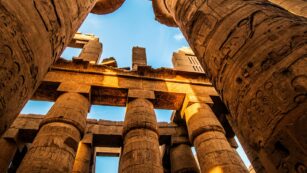Ancient architecture styles are a testament to human ingenuity and artistic expression, spanning across various civilizations and millennia. From the grand pyramids of Egypt to the intricate temples of India, these structures not only showcase the aesthetic preferences of their times but also reflect the technological advancements and cultural values of ancient societies. As they stand against the sands of time, these architectural marvels continue to fascinate historians, architects, and travelers alike.
Ancient Architecture Styles
Ancient architecture styles offer diverse views into the civilizations that shaped them, each distinct in form and function. They encapsulate the technical prowess and cultural narratives of their times, ranging from the monumental structures of Egypt to the refined temples of Greece and the innovative engineering of Roman constructions.
Egyptian Architecture
 Egyptian architecture is noted for its monumental and symbolic structures, such as pyramids and temples. The cornerstone of this style includes massive stone buildings with sloping walls and flat roofs, primarily built for religious and funerary purposes. Structures like the Great Pyramid of Giza exemplify this style, featuring precise engineering to align with celestial phenomena. The use of colossal columns and detailed hieroglyphic decorations also emphasizes a blend of functionality and spirituality in Egyptian architecture.
Egyptian architecture is noted for its monumental and symbolic structures, such as pyramids and temples. The cornerstone of this style includes massive stone buildings with sloping walls and flat roofs, primarily built for religious and funerary purposes. Structures like the Great Pyramid of Giza exemplify this style, featuring precise engineering to align with celestial phenomena. The use of colossal columns and detailed hieroglyphic decorations also emphasizes a blend of functionality and spirituality in Egyptian architecture.
Greek Architecture
Greek architecture is celebrated for its introduction of architectural orders—Doric, Ionic, and Corinthian—each characterized by their distinctive columns and entablatures. This style emphasizes symmetry, proportion, and the pursuit of aesthetic perfection. Key examples include the Parthenon in Athens, which epitomizes the use of the Doric order, and the Erectheion, noted for its elegant Ionic columns. Greek architecture significantly influenced aesthetic values, emphasizing harmony and balance that have resonated through the ages.
Roman Architecture
 Roman architecture is known for its vast range and introduction of structural innovations such as domes, vaults, and arches. These features facilitated the creation of expansive and durable structures like the Pantheon and the Colosseum. Romans excelled in the use of concrete, which allowed them to engineer complex building forms that were not only functional but also grand in scale. This architecture style also highlighted the importance of urban planning, incorporating roads, aqueducts, and forums that laid the foundation for modern city planning.
Roman architecture is known for its vast range and introduction of structural innovations such as domes, vaults, and arches. These features facilitated the creation of expansive and durable structures like the Pantheon and the Colosseum. Romans excelled in the use of concrete, which allowed them to engineer complex building forms that were not only functional but also grand in scale. This architecture style also highlighted the importance of urban planning, incorporating roads, aqueducts, and forums that laid the foundation for modern city planning.
Key Features of Ancient Architectural Designs
Exploring the key features of ancient architectural designs reveals the ingenuity and foresight of early builders. These features, born from necessity and refined through innovation, have left a lasting influence on architecture worldwide.
Emphasis on Durability and Material Use
 Ancient architectures prioritized durability, using materials that have stood the test of time. For example, the Egyptians utilized limestone and granite while the Romans perfected the use of concrete. These choices ensured that their structures would not only last for centuries but also withstand various environmental challenges.
Ancient architectures prioritized durability, using materials that have stood the test of time. For example, the Egyptians utilized limestone and granite while the Romans perfected the use of concrete. These choices ensured that their structures would not only last for centuries but also withstand various environmental challenges.
Symmetry and geometry were central to ancient designs, reflecting a deep understanding of aesthetics and balance. Greek architectures, like the Parthenon, showcase this with their meticulously calculated dimensions and proportionately spaced columns. This approach not only enhanced the visual appeal of the structures but also provided structural stability.
Integration with the Natural Environment
Ancient builders excelled in integrating constructions with their surrounding landscape, demonstrating an early form of sustainable design. For instance, Indian temple architectures often mirrored the scale and complexity of nearby mountain ranges, creating a harmonious balance between human-made and natural elements.
Advanced Engineering Techniques
 The adoption of advanced engineering techniques allowed for the creation of structures that were revolutionary for their time. Roman architectures introduced the arch and dome, which dramatically expanded the possibilities for the scale and scope of their constructions. These innovations also contributed to the acoustics and functionality of public spaces, like amphitheaters and bathhouses.
The adoption of advanced engineering techniques allowed for the creation of structures that were revolutionary for their time. Roman architectures introduced the arch and dome, which dramatically expanded the possibilities for the scale and scope of their constructions. These innovations also contributed to the acoustics and functionality of public spaces, like amphitheaters and bathhouses.
Ornamentation in ancient architecture went beyond mere decoration; it served as a narrative tool that conveyed stories and values of the culture. Egyptian buildings often featured intricate hieroglyphics that recorded significant historical events and religious practices. Similarly, Roman and Greek structures displayed reliefs and frescoes that reflected their gods, myths, and daily life.
By understanding these key features, it becomes apparent why ancient architectural designs are not only marvels of the construction world but also significant cultural artifacts that offer insight into the societies that created them.

